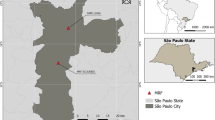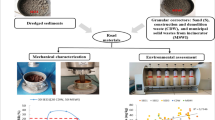Abstract
Demolition wastes may be used in different civil engineering applications as road constructions, concrete, and embankments or landfill. Regardless its application, leaching tests of the waste should be carried out to assess concentrations of pollutants. Concrete, brick and mixture of concrete, bricks, tiles and ceramics wastes were subject to percolation test—CEN/TS 14405, and batch test—SR EN 12457. The leachates were analyzed with respect to concentration of inorganic elements—arsenic, barium, cadmium, chromium, copper, mercury, molybdenum, nickel, lead, selenium, zinc, fluoride, chloride and sulfate, and organic compounds (phenol index). The concentrations of elements in leachates were compared with the limit values of European regulation for the acceptance of inert wastes at landfills. Generally, the releases of inorganic species in leachates were below limits values. Some waste leachates obtained by percolation and batch test had high values for phenol index.

Similar content being viewed by others
References
Directive 2008/98/EC (2008) Directive 2008/98/EC of the European Parliament and of the Council of 19 November 2008 on waste and repealing certain Directives. In: Off J Eur Union L312/3
Roussat N, Mehu J, Abdelghafour M, Brula P (2008) Leaching behavior of hazardous demolition waste. Waste Manag 28:2032–2040. doi:10.1016/j.wasman.2007.10.019
The National Environmental Protection Agency (2013) National Report on the state of environment. http://www.anpm.ro/upload/116008_RSM-2012.pdf. Accessed 14 Dec 2015
Krueger R, Ham RK, Boyle WC (1989) The variability of ferrous foundry waste leaching characteristics and comparison to landfill unsaturated zone leachate quality. 43rd Purdue University industrial waste conference proceedings. 605–616
Pacheco-Torgal F, Tam V, Labrincha J, Ding Y, de Brito J (eds) (2013) Handbook of recycled concrete and demolition waste. Elsevier, Amsterdam
European list of waste (2000) Commission Decision replacing Decision 94/3/EC establishing a list of wastes pursuant to Article 1(a) of Council Directive 75/442/EEC on waste and Council Decision 94/904/EC establishing a list of hazardous waste pursuant to Article 1(4) of Council Directive 91/689/EEC on hazardous waste
Jang YC, Townsend TG (2001) Occurrence of organic pollutants in recovered soil fines from construction and demolition waste. Waste Manag 21:703–715. doi:10.1016/S0956-053X(01)00007-1
Sheridan SK, Townsend TG, Price JL, Connell JT (2000) Policy options for hazardous-building-component removal before demolition. Pract Period Hazard Toxic Radioact Waste Manag 4:111–117. doi:10.1061/(ASCE)1090-025X(2000)4:3(111)
Weber JW, Jang YC, Townsend TG, Laux S (2002) Leachate from land disposed residential construction waste. J Environ Eng 128:237–245. doi:10.1061/(ASCE)0733-9372(2002)128:3(237)
Behiry AEAEM (2013) Utilization of cement treated recycled concrete aggregates as base or subbase layer in Egypt. Ain Shams Eng J 4:661–673. doi:10.1016/j.asej.2013.02.005
Jimenez J, Ayuso J, Galvin A, Lopez M, Agrela F (2012) Use of mixed recycled aggregates with a low embodied energy from non-selected CDW in unpaved rural roads. Constr Build Mater 34:34–43. doi:10.1016/j.conbuildmat.2012.02.042
Jankovic K, Nikolic D, Bojovic D (2012) Concrete paving blocks and flags made with crushed brick as aggregate. Constr Build Mater 28:659–663. doi:10.1016/j.conbuildmat.2011.10.036
Hendricks CF, Janssen GMT (2001) Reuse of construction and demolition waste in the Netherlands for road constructions. Heron J 46:109–117. http://heronjournal.nl/46-2/4.pdf. Accessed 11 Dec 2015
Aljassar AH, Al-Fadala KB, Ali AM (2005) Recycling building demolition waste in hot-mix asphalt concrete: a case study in Kuwait. J Mater Cycles Waste Manage 7:112–115. doi:10.1007/s10163-005-0135-4
Silva RV, de Brito J, Dhir RK (2014) Properties and composition of recycled aggregates from construction and demolition waste suitable for concrete production. Constr Build Mater 65:201–217. doi:10.1016/j.conbuildmat.2014.04.117
Cabral AEB (2013) Chapter concrete with construction and demolition wastes, eco-efficient concrete, civil and structural engineering. Woodhead Publishing Limited, India
Evangelista L, De Brito J (2010) Durability performance of concrete made with fine recycled concrete aggregates. Cem Concr Compos 32:9–14. doi:10.1016/j.cemconcomp.2009.09.005
Chakradhara Rao M, Bhattacharyya S.K, Barai SV (2010) Recycled aggregate concrete: a sustainable built environment. International conference on sustainable built environment, Kandy, 227–232
Safiuddin M, Johnson Alengaram U, Abdus Salam Md, Zamin Jumaat M, Fadhli Jaafar F, Binti Saad H (2011) Properties of high-workability concrete with recycled concrete aggregate. Mater Res 14:248–255. doi:10.1590/S1516-14392011005000039
Sagoe C, Brown T, Taylor A (2001) Performance of concrete made with commercially produced coarse recycled concrete aggregate. Cem Concr Res 31:707–712. doi:10.1016/S0008-8846(00)00476-2
Tam V, Wang K, Tamb CM (2008) Assessing relationships among properties of demolished concrete, recycled aggregate and recycled aggregate concrete using regression analysis. J Hazard Mater 152:703–714. doi:10.1016/j.jhazmat.2007.07.061
Evangelista L, de Brito J (2014) Concrete with fine recycled aggregates: a review. Eur J Environ Civil Eng 18:129–172. doi:10.1080/19648189.2013.851038
Tam V, Gao XF, Tam CM (2005) Microstructural analysis of recycled aggregate concrete produced from two-stage mixing approach. Cem Concr Res 35:1195–1203. doi:10.1016/j.cemconres.2004.10.025
Herbudiman B, Saptaji AM (2013) Self-compacting concrete with recycled traditional roof tile powder. Procedia Eng 54:805–816. doi:10.1016/j.proeng.2013.03.074
De Brito J, Pereira AS, Correia JR (2005) Mechanical behavior of non-structural concrete made, with recycled ceramic aggregates. Cem Concr Compos 27:429–433. doi:10.1016/j.cemconcomp.2004.07.005
SR EN 12457-1 (2003). Characterization of waste—leaching—compliance test for leaching of granular waste materials and sludges—Part 1: one stage batch test at a liquid to solid ratio of 2 l/kg for materials with high solid content and with particle size below 4 mm (without or with size reduction)
SR EN 12457-2 (2003). Characterization of waste—leaching—compliance test for leaching of granular waste materials and sludges—Part 2: one stage batch test at a liquid to solid ratio of 10 l/kg for materials with particle size below 4 mm (without or with size reduction)
CEN/TS 14405 (2004). Characterization of waste—leaching behavior tests—up-flow percolation test (under specified conditions)
Pacheco Torgal F, Miraldo S, Labrincha JA, De Brito J (2012) An overview on concrete carbonation in the context of eco-efficient construction: evaluation, use of SCMs and/or RAC. Constr Build Mater 36:141–150
Engelsen Christian CJ, Van der Sloot HA, Wibetoe G, Petkovic G, Stoltenberg-Hansson E, Lund W (2009) Release of mayor elements from recycled concrete aggregates and geochemical modelling. Cem Concr Res 39:446–459. doi:10.1016/j.cemconres.2009.02.001
Butera S, Christensen TH, Astrup TF (2014) Composition and leaching of construction and demolition waste: inorganic elements and organic compounds. J Hazard Mater 276:302–311. doi:10.1016/j.jhazmat.2014.05.033
Wahlstrom M, Laine-Ylijoki J, Maatanen A, Luotojarvi T, Kivekas L (2000) Environmental quality assurance system for use of crushed mineral demolition wastes in road constructions. Waste Manag 20:225–232. doi:10.1016/S0956-053X(99)00319-0
Barbudo A, Galvin A, Agrela F, Ayuso J, Jimenez JR (2012) Correlation analysis between sulfate content and leaching of sulfates in recycled aggregates from construction and demolition wastes. Waste Manag 32:1229–1235. doi:10.1016/j.wasman.2012.02.005
Harber AJ, Forth RA (2001) The contamination of former iron and steel works sites. Environ Geol 40:324–330
Ghose MK (2002) Physico-chemical treatment of coke plant effluents for control of water pollution in India. Indian J Chem Technol 9:54–59
Acknowledgments
This work was supported by the Buzau County Council under project LIFE10 ENV/RO/000727—Recovery of Construction and Demolition Waste in Buzau County”, financed under the LIFE+ Programme of the European Commission—Environment Policy and Governance component.
Author information
Authors and Affiliations
Corresponding author
Rights and permissions
About this article
Cite this article
Saca, N., Dimache, A., Radu, L.R. et al. Leaching behavior of some demolition wastes. J Mater Cycles Waste Manag 19, 623–630 (2017). https://doi.org/10.1007/s10163-015-0459-7
Received:
Accepted:
Published:
Issue Date:
DOI: https://doi.org/10.1007/s10163-015-0459-7




